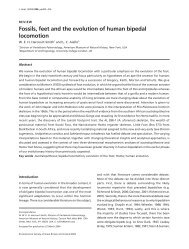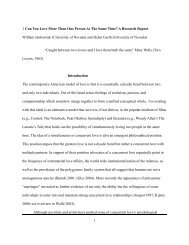Why do humans reason? Arguments for an argumentative theory
Why do humans reason? Arguments for an argumentative theory
Why do humans reason? Arguments for an argumentative theory
You also want an ePaper? Increase the reach of your titles
YUMPU automatically turns print PDFs into web optimized ePapers that Google loves.
References/Mercier & Sperber: <strong>Why</strong> <strong>do</strong> <strong>hum<strong>an</strong>s</strong> <strong>reason</strong>?Anderson, C. A., New, B. L. & Speer, J. R. (1985) Argument availability as amediator of social <strong>theory</strong> persever<strong>an</strong>ce. Social Cognition 3(3):235–49.[aHM]Anderson, E. (2006) The epistemology of democracy. Episteme: Journal of SocialEpistemology 3(1–2):8–22. [KC-CW]Anderson, T., Howe, C., Soden, R., Halliday, J. & Low, J. (2001) Peer interaction<strong>an</strong>d the learning of critical thinking skills in further education students.Instructional Science 29(1):1–32. [aHM]Anderson, T., Howe, C. & Tolmie, A. (1996) Interaction <strong>an</strong>d mental models ofphysics phenomena: Evidence from dialogues between learners. In: Mentalmodels in cognitive science: Essays in honour of Phil Johnson-Laird, ed.J. Oakhill & A. Garnham, pp. 247–73. Psychology Press. [aHM]Ariely, D., Gneezy, U., Loewenstein, G. & Mazar, N. (2009) Large stakes <strong>an</strong>d bigmistakes. Review of Economic Studies 76(2):451–69. [aHM]Ariely, D. & Levav, J. (2000) Sequential choice in group settings: Taking the roadless traveled <strong>an</strong>d less enjoyed. Journal of Consumer Research 27(3):279–90.[aHM]Arkes, H. R. & Ayton, P. (1999) The sunk cost <strong>an</strong>d Concorde effects: Are <strong>hum<strong>an</strong>s</strong>less rational th<strong>an</strong> lower <strong>an</strong>imals? Psychological Bulletin 125(5):591–600.[aHM]Arkes, H. R. & Blumer, C. (1985) The psychology of sunk cost. Org<strong>an</strong>izationalBehavior <strong>an</strong>d Hum<strong>an</strong> Decision Processes 35(1):124–40. [aHM]Arkes, H. R., Guilmette, T. J., Faust, D. & Hart, K. (1988) Eliminating the hindsightbias. Journal of Applied Psychology 73(2):305–307. [aHM]Arleo, A. & Gerstner, W. (2000) Spatial cognition <strong>an</strong>d neuro-mimetic navigation: Amodel of hippocampal place cell activity. Biological Cybernetics 83(3):287–99. [JW]Augustinova, M. (2008) Falsification cueing in collective <strong>reason</strong>ing: Example of theWason selection task. Europe<strong>an</strong> Journal of Social Psychology 38(5):770–85.[aHM]Bailenson, J. N. & Rips, L. J. (1996) In<strong>for</strong>mal <strong>reason</strong>ing <strong>an</strong>d burden of proof.Applied Cognitive Psychology 10(7):S3–16. [MH, arHM]Ball, L. J. (2010) The dynamics of <strong>reason</strong>ing: Chronometric <strong>an</strong>alysis <strong>an</strong>d dualprocesstheories. In: The science of <strong>reason</strong>: A festschrift <strong>for</strong> Jonath<strong>an</strong> St. B. T.Ev<strong>an</strong>s, ed. K. I. M<strong>an</strong>ktelow, D. E. Over & S. Elqayam, pp. 283–307. PsychologyPress. [EJNS]Ball, L. J., Philips, P., Wade, C. N. & Quayle, J. D. (2006) Effects of belief <strong>an</strong>d logicon syllogistic <strong>reason</strong>ing: Eye-movement evidence <strong>for</strong> selective processingmodels. Experimental Psychology 53:77–86. [WDN, EJNS]B<strong>an</strong>dura, A. (1990) Selective activation <strong>an</strong>d disengagement of moral control.Journal of Social Issues 46(1):27–46. [aHM]B<strong>an</strong>dura, A., Barbar<strong>an</strong>elli, C., Caprara, G. V. & Pastorelli, C. (1996) Mech<strong>an</strong>isms ofmoral disengagement in the exercise of moral agency. Journal of Personality<strong>an</strong>d Social Psychology 71:364–74. [aHM]Barber, B. M., Heath, C. & Ode<strong>an</strong>, T. (2003) Good <strong>reason</strong>s sell: Reason-basedchoice among group <strong>an</strong>d individual investors in the stock market. M<strong>an</strong>agementScience 49(12):1636–52. [aHM]Bar-Hillel, M. (1980) The base-rate fallacy in probability judgments. Acta Psychologica44:211–33. [MO]Barkow, J. H., Cosmides, L. & Tooby, J., eds. (1992) The adapted mind. Ox<strong>for</strong>dUniversity Press. [aHM]Baron, J. (1994) Nonconsequentialist decisions. Behavioral <strong>an</strong>d Brain Sciences17:1–42. [JStBTE]Baron, J. (1995) Myside bias in thinking about abortion. Thinking & Reasoning1:221–35. [CRW]Barrouillet, P., Grosset, N. & Lecas, J.-F. (2000) Conditional <strong>reason</strong>ing by mentalmodels: Chronometric <strong>an</strong>d developmental evidence. Cognition 75:237–66.[JEO]Baumeister, R. F. (1997) Evil: Inside hum<strong>an</strong> violence <strong>an</strong>d cruelty. Freem<strong>an</strong>.[aHM]Baumeister, R. F. (2005) The cultural <strong>an</strong>imal: Hum<strong>an</strong> nature, me<strong>an</strong>ing, <strong>an</strong>d sociallife. Ox<strong>for</strong>d University Press. [RFB]Baumeister, R. F. & Masicampo, E. J. (2010) Conscious thought is <strong>for</strong> facilitatingsocial <strong>an</strong>d cultural interactions: How mental simulations serve the <strong>an</strong>imal–culture interface. Psychological Review 117:945–71. [RFB]Baumeister, R. F., Masicampo, E. J. & Vohs, K. D. (2011) Do conscious thoughtscause behavior? Annual Review of Psychology 62:331–62. [RFB]Bazerm<strong>an</strong>, M. H., Loewenstein, G. F. & White, S. B. (1992) Reversals of preferencein allocation decisions: Judging <strong>an</strong> alternative versus choosing among alternatives.Administrative Science Quarterly 37(2):220–40. [aHM]Beatty, A. S., Reese, C. M., Persky, H. R. & Carr, P. (1996) NAEP 1994 U.S. HistoryReport Card: Findings from the National Assessment of Educational Progress.U. S. Department of Education. Available at: http://nces.ed.gov/pubsearch/pubsinfo.asp?pubid ¼ 96085 [CRW]Bechara, A. (2005) Decision making, impulse control <strong>an</strong>d loss of willpower to resistdrugs: A neurocognitive perspective. Nature Neuroscience 8:1458–63. [DN]Becker, G. & Stigler, G. J. (1977) De gustibus non est disput<strong>an</strong>dum. Americ<strong>an</strong>Economic Review 67:76–90. [EUW]Berger, J. A. & Heath, C. (2007) Where consumers diverge from others: Identitysignaling <strong>an</strong>d product <strong>do</strong>mains. Journal of Consumer Research 34(2):121–34. [aHM]Bersoff, D. M. (1999) <strong>Why</strong> good people sometimes <strong>do</strong> bad things: Motivated<strong>reason</strong>ing <strong>an</strong>d unethical behavior. Personality <strong>an</strong>d Social Psychology Bulletin25(1):28–39. [aHM]Besnard, P. & Hunter, A. (2008) Elements of argumentation. MIT Press. [JF]Billig, M. (1996) Arguing <strong>an</strong>d thinking: A rhetorical approach to social psychology.Cambridge University Press. [DK, aHM]Blaisdell, A. P., Sawa, K., Leising, K. J. & Waldm<strong>an</strong>n, M. R. (2006) Causal <strong>reason</strong>ingin rats. Science 311(5763):1020–22. [aHM]Bl<strong>an</strong>chette, I. & Dunbar, K. (2001) Analogy use in naturalistic settings: The influenceof audience, emotion, <strong>an</strong>d goals. Memory & Cognition 29(5):730–35. [aHM]Blinder, A. S. & Morg<strong>an</strong>, J. (2000) Are two heads better th<strong>an</strong> one? An experimental<strong>an</strong>alysis of group vs. individual decision making. NBER Working Paper 7909,National Bureau of Economic Research, Princeton, NJ. [aHM]Bloom, P. (2010) How <strong>do</strong> morals ch<strong>an</strong>ge? Nature 464(7288):490. [rHM]Blum-Kulka, S., Blondheim, M. & Hacohen, G. (2002) Traditions of dispute: Fromnegotiations of Talmudic texts to the arena of political discourse in the media.Journal of Pragmatics 34(10–11):1569–94. [aHM]Boehm, C., with comments by Antweiler, C., Eibl-Eibesfeldt, I., Kent, S., Knauft,B. M., Mithen, S., Richerson, P. J. & Wilson, D. S. (1996) Emergencydecisions, cultural-selection mech<strong>an</strong>ics, <strong>an</strong>d group selection. CurrentAnthropology 37(5):763–93. [aHM]Boiney, L. G., Kennedy, J. & Nye, P. (1997) Instrumental bias in motivated<strong>reason</strong>ing: More when more is needed. Org<strong>an</strong>izational Behavior <strong>an</strong>d Hum<strong>an</strong>Decision Processes 72(1):1–24. [aHM]Bond, S. D., Carlson, K. A., Meloy, M. G., Russo, J. E. & T<strong>an</strong>ner, R. J. (2007)Precommitment bias in the evaluation of a single option. Org<strong>an</strong>izational Behavior<strong>an</strong>d Hum<strong>an</strong> Decision Processes 102(2):240–54. [aHM]Bonner, B. L., Baum<strong>an</strong>n, M. R. & Dalal, R. S. (2002) The effects of memberexpertise on group decision making <strong>an</strong>d per<strong>for</strong>m<strong>an</strong>ce. Org<strong>an</strong>izational Behavior<strong>an</strong>d Hum<strong>an</strong> Decision Processes 88:719–36. [aHM]Bonner, C. & Newell, B. R. (2010) In conflict with ourselves? An investigation ofheuristic <strong>an</strong>d <strong>an</strong>alytic processes in decision making. Memory & Cognition38:186–96. [WDN]Bonner, S. E., Hastie, R., Sprinkle, G. B. & Young, S. M. (2000) A review of theeffects of fin<strong>an</strong>cial incentives on per<strong>for</strong>m<strong>an</strong>ce in laboratory tasks: Implications<strong>for</strong> m<strong>an</strong>agement accounting. Journal of M<strong>an</strong>agement Accounting Research12(1):19–64. [aHM]Bonner, S. E. & Sprinkle, G. B. (2002) The effects of monetary incentives on ef<strong>for</strong>t<strong>an</strong>d task per<strong>for</strong>m<strong>an</strong>ce: Theories, evidence, <strong>an</strong>d a framework <strong>for</strong> research.Accounting, Org<strong>an</strong>izations <strong>an</strong>d Society 27(4–5):303–45. [aHM]Bragger, J. D., H<strong>an</strong>tula, D. A., Bragger, D., Kirn<strong>an</strong>, J. & Kutcher, E. (2003) Whensuccess breeds failure: History, hysteresis, <strong>an</strong>d delayed exit decisions. Journalof Applied Psychology 88(1):6–14. [aHM]Bragger, J. L., Bragger, D. H., H<strong>an</strong>tula, D. A. & Kirn<strong>an</strong>, J. P. (1998) Hysteresis <strong>an</strong>duncertainty: The effect of in<strong>for</strong>mation on delays to exit decisions. Org<strong>an</strong>izationalBehavior <strong>an</strong>d Hum<strong>an</strong> Decision Processes 74(3):229–53. [aHM]Braine, M. D. S. & O’Brien, D. P. (1998) Mental logic. Erlbaum. [JEO]Bram<strong>an</strong>, E. (2009) Law, politics, <strong>an</strong>d perception: How policy preferences influencelegal <strong>reason</strong>ing. University of Virginia Press. [aHM]Bratm<strong>an</strong>, M. E. (1987) Intention, pl<strong>an</strong>s, <strong>an</strong>d practical <strong>reason</strong>. Harvard UniversityPress. [KF]Brem, S. K. & Rips, L. J. (2000) Expl<strong>an</strong>ation <strong>an</strong>d evidence in in<strong>for</strong>mal argument.Cognitive Science 24:573–604. [aHM]Briley, D. A., Morris, M. W. & Simonson, I. (2000) Reasons as carriers of culture:Dynamic versus dispositional models of cultural influence on decision making.Journal of Consumer Research 27(2):157–78. [aHM]Britt, M. A. & Kurby, C. A. (2005) Detecting incoherent in<strong>for</strong>mal arguments. Paperpresented at the 15th Annual Meeting of the Society <strong>for</strong> Text <strong>an</strong>d Discourse,Amsterdam, The Netherl<strong>an</strong>ds. [CRW]Britt, M. A., Kurby, C. & Wolfe, C. R. (2005) Memory <strong>for</strong> claims of simple arguments.Paper presented at the 15th Annual Meeting of the Society <strong>for</strong> Text <strong>an</strong>dDiscourse. Amsterdam, The Netherl<strong>an</strong>ds. [CRW]Britt, M. A., Kurby, C. A., D<strong>an</strong><strong>do</strong>tkar, S. & Wolfe, C. R. (2008) I agreed with what?Memory <strong>for</strong> simple argument claims. Discourse Processes 45:52–84. [CRW]Britt, M. A. & Larson, A. A. (2003) Constructing representations of arguments.Journal of Memory <strong>an</strong>d L<strong>an</strong>guage 48:794–810. [CRW]Brock, T. C. (1967) Communication discrep<strong>an</strong>cy <strong>an</strong>d intent to persuade as determin<strong>an</strong>tsof counterargument production. Journal of Experimental Social Psychology3(3):269–309. [aHM]Brown, C. L. & Carpenter, G. S. (2000) <strong>Why</strong> is the trivial import<strong>an</strong>t? A <strong>reason</strong>sbasedaccount <strong>for</strong> the effects of trivial attributes on choice. Journal of ConsumerResearch 26(4):372–85. [aHM]Brown, D. E. (1991) Hum<strong>an</strong> universals. McGraw-Hill. [aHM]Brownstein, A. L. (2003) Biased predecision processing. Psychological Bulletin129(4):545–68. [aHM]102 BEHAVIORAL AND BRAIN SCIENCES (2011) 34:2




